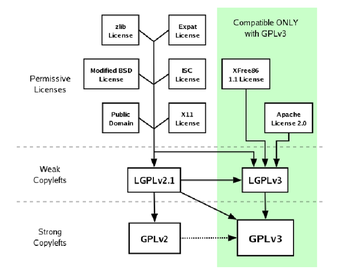FSF Publishes New Quick Guide on GPLv3
The quick guide gives a short and understandable explanation of the objectives of version 3 of the GPL; recent discussions on GPLv3 had caused many developers to forget the generic purpose of the license – guaranteeing the freedom of software development.
The document briefly recapitulates what the General Public License (GPL) aims to achieve. The author goes on to explain the changes between versions 2 and 3 of the GPL, and the motivations behind the changes citing three threats to freedom. One of them is tivoization, named after the Tivo digital video recorder that contains GPL’d software but prevents users from modifying the GPL programs by validating a digital signature. The other two threats that led to changes in the GPL are Digital Rights Management and Microsoft’s patent covenenant. The author also refers to interfaces to other licenses. The author of the Quick Guide, Brett Smith from the Free Software Foundation (FSF), has posted the guide on the FSF announce mailing list.

The changes introduced by GPLv3 include new compatibilities to other licenses, as shown by the graphic from the Quick Guide.
The Open Source community can view the text as an impetus to understand the GPL as an opportunity rather than a bone of contention or a threat. Brett’s short, informal announcement closes with the words: "We hope this serves as a useful resource for developers considering adopting GPLv3 for their own projects." Shortly afterwards a senior Red Hat developer commented: "Excellent job, Brett."
The guide is available online, or as a PDF document, and as a zipped tarball in text only format. According to GNU's Who Brett Smith has been with the Free Software Foundation since 2002, and has worked as the Chief Webmaster and Shipping Manager, before becoming the "licensing guru" at the FSF’s licensing and compliance lab which provides “the public with a "knowledge infrastructure" surrounding the GNU GPL and free software licensing, and enforcing the license on FSF-copyrighted software.”
Subscribe to our Linux Newsletters
Find Linux and Open Source Jobs
Subscribe to our ADMIN Newsletters
Support Our Work
Linux Magazine content is made possible with support from readers like you. Please consider contributing when you’ve found an article to be beneficial.

News
-
Fedora 43 Has Finally Landed
The Fedora Linux developers have announced their latest release, Fedora 43.
-
KDE Unleashes Plasma 6.5
The Plasma 6.5 desktop environment is now available with new features, improvements, and the usual bug fixes.
-
Xubuntu Site Possibly Hacked
It appears that the Xubuntu site was hacked and briefly served up a malicious ZIP file from its download page.
-
LMDE 7 Now Available
Linux Mint Debian Edition, version 7, has been officially released and is based on upstream Debian.
-
Linux Kernel 6.16 Reaches EOL
Linux kernel 6.16 has reached its end of life, which means you'll need to upgrade to the next stable release, Linux kernel 6.17.
-
Amazon Ditches Android for a Linux-Based OS
Amazon has migrated from Android to the Linux-based Vega OS for its Fire TV.
-
Cairo Dock 3.6 Now Available for More Compositors
If you're a fan of third-party desktop docks, then the latest release of Cairo Dock with Wayland support is for you.
-
System76 Unleashes Pop!_OS 24.04 Beta
System76's first beta of Pop!_OS 24.04 is an impressive feat.
-
Linux Kernel 6.17 is Available
Linus Torvalds has announced that the latest kernel has been released with plenty of core improvements and even more hardware support.
-
Kali Linux 2025.3 Released with New Hacking Tools
If you're a Kali Linux fan, you'll be glad to know that the third release of this famous pen-testing distribution is now available with updates for key components.
